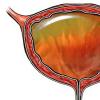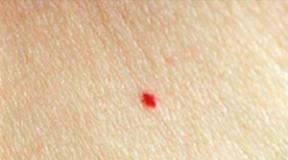Vermox Janssen-silag: instructions for use. Vermox - instructions for use Vermox types
active substance: 1 tablet contains 100 mg of mebendazole;
Excipients: microcrystalline cellulose, sodium starch glycolate (type A), talc, corn starch, sodium saccharin, magnesium stearate, hydrogenated cottonseed oil, orange flavor, colloidal anhydrous silica, sodium lauryl sulfate, orange-yellow S (E 110).
Pharmacotherapeutic group
Anthelmintics.
CodeATX: P02CA01.
Indications
Vermox® is indicated for the treatment of mono- or mixed infestations caused by Enterobius vermicularis (pinworms); Ascaris lumbricoides (large roundworms [roundworms]); Trichuris trichiura (whipworm); Ancylostoma duodenale (common hookworm); Necator americanus (necator); Strongyloides stercoralis; Taenia saginata and Taenia solium (tapeworms [bovine tapeworm and pork tapeworm]).
Contraindications
Vermox® is contraindicated in patients with hypersensitivity to mebendazole or any of the excipients.
Vermox® is contraindicated during pregnancy.
Directions for use and doses
At enterobiasis adults and children over 2 years of age are prescribed 1 tablet (100 mg) of the drug once. To prevent re-infestation, you should repeat taking 1 tablet (100 mg) of the drug after 2 or 4 weeks.
At ascariasis, trichuriasis, hookworm or combinations thereof, adults and children over 2 years of age are prescribed 1 tablet (100 mg) twice a day (morning and evening) for 3 days.
At taeniasis and strongyloidiasis adults are recommended to take 2 tablets (200 mg) twice a day (morning and evening) for 3 days; Children over 2 years of age are prescribed 1 tablet (100 mg) twice a day (morning and evening) for 3 days.
Information on the use of the drug in children under 2 years of age is contained in the section "Children".
The tablets can be chewed or swallowed whole, regardless of the time of meal. For young children, the tablet must be crushed before use.
If the next dose of the drug was missed, then you should not double the dose during the next dose.
Adverse reactions
By frequency, adverse reactions that were observed are classified as follows: very often (≥ 1/10), often (≥ 1/100 to< 1/10), нечасто (≥ 1/1000 до < 1/100), редко (≥ 1/10 000 до < 1/1000), очень редко (< 1/10 000, включая отдельные сообщения).
From the blood and lymphatic system:
very rarely - neutropenia.
From the immune system:
very rarely - hypersensitivity, including anaphylactic and anaphylactoid reactions.
From the central nervous system:
very rarely - convulsions, dizziness.
From the gastrointestinal tract:
uncommon – abdominal discomfort, diarrhea, flatulence.
From the hepatobiliary system:
very rarely - hepatitis, increased activity of liver enzymes.
From the skin and its appendages:
uncommon – rash;
very rarely - toxic epidermal necrolysis, Stevens-Johnson syndrome, exanthema, angioedema, urticaria, alopecia, itching.
If the listed reactions occur, as well as reactions not listed in these instructions, the patient should consult a doctor.
Overdose
In patients who used doses higher than recommended or were treated for a long time, alopecia, reversible liver dysfunction, hepatitis, agranulocytosis, neutropenia and glomerulonephritis were rarely observed. Such adverse reactions, with the exception of agranulocytosis and glomerulonephritis, were also observed in patients who used mebendazole in standard dosage (see section "Adverse reactions").
Symptoms In case of accidental overdose, cramping abdominal pain, nausea, vomiting and diarrhea may occur.
Treatment. There is no specific antidote. If warranted, activated charcoal may be prescribed.
Use during pregnancy or breastfeeding
Since Vermox® is contraindicated during pregnancy, patients who are pregnant or who suspect pregnancy should not use the drug.
It is not known whether mebendazole is excreted in breast milk, therefore breastfeeding is not recommended when using the drug Vermox®.
Fertility
The results of studies of the effect of the drug Vermox® on reproductive function demonstrated no effect on the ability to conceive when taken in doses up to 10 mg/kg per day inclusive.
Children
Used to treat children over 2 years of age.
Due to the lack of experience with the use of the drug in children under 2 years of age, and also because there are isolated reports of the occurrence of seizures during the use of the drug in children of this age group, Vermox® should be prescribed only if the presence of helminthic infestation is seriously noted on the their nutritional status and physical development.
Features of application
When using the drug there is no need to prescribe a diet or use laxatives.
Results from clinical studies indicate a possible association between the use of mebendazole and metronidazole and the occurrence of Stevens-Johnson syndrome/toxic epidermal necrolysis. The simultaneous use of mebendazole and metronidazole should be avoided.
The ability to influence reaction speed when driving or workingwith other mechanisms
There are no messages at the moment. When driving a vehicle or working with other mechanisms, it is recommended to exercise extreme caution, taking into account the possibility of developing undesirable reactions from the nervous system.
Interaction with other drugs and other types of interactions
Concomitant use with cimetidine can lead to an increase in the effect of Vermox due to inhibition of its metabolism in the liver and an increase in the concentration of mebendazole in plasma.
The simultaneous use of mebendazole and metronidazole should be avoided (see section "Peculiarities of use").
Pharmacological properties
Pharmacodynamics.
Pharmacokinetics.
Absorption. After oral administration, less than 10% of the dose reaches the systemic circulation due to incomplete absorption and extensive first-pass metabolism (first-pass effect). Maximum plasma concentrations are achieved 2–4 hours after administration. Simultaneous use of the drug with high-calorie food leads to a slight increase in the bioavailability of mebendazole.
Distribution. 90–95% of the drug dose is bound to plasma proteins.
The volume of distribution is 1–2 l/kg, indicating that mebendazole penetrates beyond the blood vessels. This is supported by data on the presence of mebendazole in tissues in patients on long-term therapy (eg, 40 mg/kg per day for 3 to 21 months).
Metabolism. After oral administration, mebendazole is metabolized primarily in the liver.
Plasma concentrations of its main metabolites are significantly higher than those of mebendazole. Impaired liver function, metabolic disorders or impaired bile secretion may lead to increased plasma levels of mebendazole.
IN 1 tablet 100 mg mebendazole.
Sodium lauryl sulfate, magnesium stearate, silicon dioxide, sodium saccharinate, starch, lactose monohydrate, talc, as excipients.
In 5 ml suspensions 100 mg medendazole.
Release form
- Suspension 2%.
- Tablets 100 mg.
pharmachologic effect
Anthelmintic .
Pharmacodynamics and pharmacokinetics
Pharmacodynamics
Detrimental effect on eggs roundworm , hookworm . In large doses it is used for the treatment of extraintestinal helminthiasis. The drug is well tolerated.
Pharmacokinetics
Almost not absorbed in the intestines. 90% binds to blood proteins. The half-life is from 2.5 to 5 hours. Accumulates in helminth larvae, liver and adipose tissue. Metabolized in the liver. About 5-10% of the drug is absorbed and then excreted by the kidneys. More than 90% is excreted in feces.
Indications for use
- strongyloidiasis ;
- enterobiasis ;
- trichocephalosis ;
- taeniasis ;
- trichinosis ;
- alveococcosis ;
- echinococcosis ;
- capillariasis ;
- mixed helminthiasis .
Contraindications
- liver failure ;
- ulcerative ;
- increased sensitivity;
- age up to 2 years;
- Crohn's disease ;
- pregnancy and breastfeeding.
Side effects
- stomach ache;
- dizziness;
- nausea.
When using high doses for a long time:
- vomiting, stool disorder;
- headache;
- rash, ;
- hair loss;
- level up creatinine ;
- hematuria And cylindruria ;
- increased activity of liver enzymes;
- leukopenia , eosinophilia , anemia .
Vermox tablets, instructions for use (Method and dosage)
The tablets are taken orally. How to take Vermox: before or after meals? The tablets are taken after meals.
Adults and children over 10 years of age with detected enterobiasis prescribed once 100 mg. Children from 2 to 5 years old: 25 mg once, from 5 to 10 years: 50 mg once. All family members are treated. If there is a high probability of reinvasion, apply again after 2 weeks at the same dosage.
At ascariasis , hookworm , taeniasis , trichocephalosis , strongyloidiasis or mixed helminthiases take 100 mg twice a day for 3 days in a row.
At trichinosis three times a day, 200-400 mg for 3 days in a row, from day 4 the dose is increased by 400-500 mg three times a day and taken until the 10th day.
The instructions for use of Vermox contain a warning that one day after taking the tablets you should not drink alcohol, fatty foods, or take laxatives. After completion of treatment, it is necessary to examine smears and feces for the presence of helminths and their eggs within 7 days. With long-term treatment, it is necessary to monitor liver and kidney function and blood tests.
Overdose
Manifested by symptoms: abdominal pain, nausea, , vomit.
When treated with high doses, there are long-term hepatitis , transient liver dysfunction, neutropenia .
Treatment begins with gastric lavage, taking sorbents , carrying out symptomatic therapy if necessary.
Interaction
Mebendazole reduces the need for insulin at .
Avoid concomitant use lipophilic substances .
Terms of sale
On prescription.
Storage conditions
At a temperature of no more than 30 C.
Best before date
Vermox for children
At enterobiasis (infection pinworms ) treatment is carried out one day: from 2 to 5 years 1/4 tablet once, from 5 to 10 years 1/2 tablet, over 10 years 1 tablet. It is necessary to take the drug again in the same dose after 2 weeks. It is also recommended to wash clothes at high temperature (90C) for all family members
You need to know that the drug causes increased motor activity of helminths, sometimes this leads to antiperistalsis , vomit and throw roundworm into the respiratory tract. Therefore, in case of intensive infestation in children, it should be used with caution.
Analogs
Level 4 ATX code matches:Analogs , Vero-Mebendazole , Mebex , , Telmox 100 .
Wormin or Vermox, which is better?
Wormil or Vermox, which is better?
Active substance albendazole . A highly effective drug for all helminthiases - treatment for enterobiasis And ascariasis before echinococcosis . This remedy is used in pediatric practice. Convenient release form - suspension 400 mg and chewable tablets 400 mg. According to doctors, the most effective drug. Manufacturer Milli Healthcare (England).
Vermox or Nemozol, which is better?
Vermox or Decaris, which is better?
has an active ingredient levamisole and its content per tablet is 50 mg or 150 mg. Tablets with a lower dosage are intended for children, prescribed from 3 years. The drugs differ in their spectrum of action. This drug only acts on roundworms ( nematodes ): roundworm , nekator , hookworm . If tests confirm parasitism by nematodes, then the drug can be taken. Manufacturer: Gedeon Richter JSC, Hungary.
Vermox is a broad-spectrum anthelmintic drug (for worms). Active ingredient: Mebendazole.
It has a fairly wide spectrum of action, but the greatest effectiveness is observed in the treatment of enterobiasis and trichuriasis.
The use of Vermox ensures an irreversible disruption of glucose utilization, which in turn leads to depletion of glycogen reserves in the tissues of helminths. The drug interferes with the synthesis of cellular tubulin, while inhibiting the synthesis of ATP (adenosine triphosphate).
Not absorbed in the intestinal tract; upon entering the blood, it is distributed in adipose tissue, liver and the body of helminth larvae. Metabolized in the liver to a 2-amino derivative and excreted by the kidneys. About 90% of the dose is excreted in the stool in its primary form.
Indications for use
What does Vermox help with? According to the instructions, the drug is prescribed in the following cases:
Instructions for use of Vermox, dosage
The drug is taken orally with a small amount of water.
Standard dosages, according to the instructions for use of Vermox:
- For enterobiasis, adults and children are prescribed 1 tablet of Vermox 100 mg once. To prevent re-infestation, the drug is repeated after 2 and 4 weeks at the same dose.
- For ascariasis, hookworm disease, trichuriasis, mixed helminthiasis, adults and children over 1 year of age are prescribed 100 mg \ 2 times a day (morning and evening) for 3 days.
- For taeniasis and strongyloidiasis, adults are recommended to take 200 mg \ 2 times a day for 3 days. Children are prescribed 100 mg 2 times a day for 3 days.
For 24 hours after taking the pills, you should not drink alcohol, fatty foods, or take laxatives. After completion of treatment, it is necessary to examine smears and feces for the presence of helminths and their eggs within 7 days.
With long-term treatment, it is necessary to monitor liver and kidney function and blood tests.
Side effects
The instructions warn about the possibility of developing the following side effects when prescribing Vermox:
- Dyspeptic disorders (abdominal pain, nausea, stool disturbances);
- Manifestations of allergic reactions (swelling, rash on the skin, urticaria); dizziness;
- Defects in fetal development during pregnancy; anemia (anemia);
- Leukopenia (decrease in the absolute content of leukocytes);
- Hematuria (blood in the urine);
- Cylindruria (a qualitative change in urine, characterized by the appearance of cylindrical bodies made of coagulated protein and blood cells).
Mebendazole reduces the need for insulin in diabetes mellitus.
Avoid simultaneous administration of lipophilic substances.
Contraindications
Vermox is contraindicated in the following cases:
- Liver failure;
- Ulcerative colitis;
- Increased sensitivity;
- Age up to 2 years;
- Crohn's disease;
- Pregnancy and breastfeeding.
Overdose
In case of overdose, headache, nausea, vomiting, diarrhea, and abdominal pain may develop.
The drug is stopped, gastric and intestinal lavage and symptomatic therapy are carried out.
Analogues of Vermox, price in pharmacies
If necessary, you can replace Vermox with an analogue of the active substance - these are the following drugs:
- Vermakar,
- Helmindazole.
Analogs by ATX code:
- Vormin,
- Gelmedazole,
- Mebendazole,
- Telmox 100.
When choosing analogues, it is important to understand that the instructions for use of Vermox, price and reviews do not apply to drugs with similar effects. It is important to consult a doctor and not change the drug yourself.
Price in pharmacies in Moscow and Russia: Vermox 100 mg 6 tablets - from 88 to 120 rubles, according to 582 pharmacies.
Store out of the reach of children at a temperature of +15... +30°C. Shelf life – 5 years.
Dispensing conditions from pharmacies are by prescription.
Content
What is Vermox
The positive effect of taking the drug is observed on 2-3 days. After being prescribed, many patients are interested in how much Vermox costs and in what form it is sold. The medicine is in tablet form. The average price of Vermox is 120 rubles. One package contains 6 tablets of 100 mg each and instructions. The drug is dispensed without a prescription.
In what cases is Vermox prescribed?
In 90% of cases, the drug is prescribed to patients suffering from helminthic infestations. Pinworms and whipworms demonstrate high sensitivity to medications of this type. After tests, Vermox is prescribed for taeniasis, ascariasis, echinococcosis, hookworm, and trichinosis. The drug treats mixed helminthiases. It will be possible to defeat the infection if you follow all the recommendations of a specialist.
- 100 mg 1 time per day to eliminate enterobiasis. The dosage is suitable for adults and children.
- 100 mg 2 times a day for the elimination of mixed helminthiases, trichuriasis, ascariasis, hookworm infections in adults and children. The medication is taken for 3 days.
- 200 mg 2 times a day to treat strongyloidiasis and taeniasis in adults. For children, the dosage is reduced by 2 times. You need to take the product for 3 days.
Vermox's instructions do not describe all methods of taking the drug. Doctors may use it to treat some specific types of nematodes. The dosage of the medicine is calculated individually. In all cases of invasion, the drug is administered in a course that involves repeated taking of the tablets after 2-3 weeks. Children under 2 years of age can be given Vermox for worms after obtaining a doctor's permission. The doctor will not allow the use of strong anthelmintics for a child under one year old, because they will cause intoxication.
How it works

How do worms come out after Vermox?
How much to wait
How do tapeworms emerge?

Contraindications and side effects of Vermox
- abdominal pain, dizziness;
- nausea and vomiting if there was an overdose;
- hair loss;
- increased activity of liver transaminases;
- anemia.
Allergic reactions may develop while taking the drug. If you notice them, you should stop taking the medicine. Doctors prescribe medicine with caution to patients suffering from diabetes. The main active component of the drug reduces the need for insulin in such people. Infected people suffering from kidney disease should refrain from taking Vermox, because. it is excreted through urine and feces. If diuresis is insufficient, the drug will be retained in the body.
Vermox should not be used by pregnant women. The risk to the fetus from taking the medicine in the first trimester is greater than its benefit. Vermox anti-worm tablets interact with lipophilic substances, so it is prohibited to use the product while taking metabolic inducers. In case of overdose, it is recommended to rinse the stomach and drink activated charcoal.
An effective drug that helps get rid of annoying worms is prescribed for primary therapy. The patient prepares for treatment in advance: strengthens the immune system, normalizes the functioning of the gastrointestinal tract. Against the background of weak immunity, a patient of any age and gender is susceptible to secondary infections (infections, bacteria, pathogenic microorganisms). The main active ingredient of the drug is mebendazole, which is used in many anthelmintic drugs. What types of helminths will Vermox help you cope with?
The medicine is available in white (sometimes with a yellow tint) tablets. The dosage of the drug is 100 mg of mebendazole. The tablets are poorly soluble in water and should be taken with a small amount of liquid after administration. Additional components of Vermox are talc, starch particles and magnesium. A remedy is taken for such types of helminths as:
- pinworms;
- roundworms;
- mixed invasions.
Among women: pain and inflammation of the ovaries. Fibroma, myoma, fibrocystic mastopathy, inflammation of the adrenal glands, bladder and kidneys develop. As well as heart disease and cancer.

Appointments for pregnant women

How does Vermox affect the fetus?
- Up to 12 weeks of pregnancy. In the initial stages, a woman should under no circumstances be treated with anthelmintic drugs. During this period, the child’s internal organs are formed, and any synthetic drugs can lead to the development of intrauterine pathologies. If helminthiasis was detected in the early stages of pregnancy, treatment is postponed until the 13th week. Before that, the woman is prescribed tonics, immunomodulators and a special diet (not harmful to the child).
- From 16 weeks of pregnancy. Among the anthelmintic drugs there are those that do not penetrate the placenta to the fetus. Effective drugs are prescribed only from the 4th month of pregnancy and a specially developed course of treatment. Vermox refers to medications that are quickly eliminated from the body of the expectant mother (they are not absorbed and do not penetrate the placenta barrier). Vermox cannot be called completely safe in the second trimester. Less than 1/10 of the drug is not completely eliminated, and the remaining active substances can harm the fetus. Self-medication during pregnancy is excluded (to avoid irreversible changes in the fetus's body).
- Throughout pregnancy. Vermox affects the functioning of the gastrointestinal tract, which in itself is a problem, especially for a pregnant woman. During the period of bearing a child, the female body is already weakened, and problems that arise can lead to more serious intestinal diseases. If the attending physician prescribes Vermox, then it is imperative to strengthen the immune system and intestines of the expectant mother.

Vermox should not harm either the mother or her child, so before taking the drug you should once again read the detailed instructions for the product and take into account all its contraindications and possible side effects.

When is Vermox prescribed?
Vermox during pregnancy is prescribed only in extreme cases. The active substances of the drug reduce the level of red blood cells and globulins in a woman’s blood, and also lead to intestinal dysfunction. How does Vermox affect the expectant mother and her child? Side effects after taking an anthelmintic with mebendazole for a woman:
From whom:

I have felt very bad for the past few years. Constant fatigue, insomnia, some kind of apathy, laziness, frequent headaches. I also had problems with digestion, and in the morning I had bad breath.
And here is my story
All this began to accumulate and I realized that I was moving in some wrong direction. I began to lead a healthy lifestyle and eat right, but this did not affect my well-being. The doctors couldn’t really say anything either. Everything seems to be normal, but I feel like my body is not healthy.
A couple of weeks later I came across an article on the Internet. literally changed my life. I did everything as it was written there and after just a few days, I felt significant improvements in my body. I began to get enough sleep much faster, and the energy that I had in my youth appeared. My head no longer hurts, my mind became clearer, my brain began to work much better. My digestion has improved, despite the fact that I now eat haphazardly. I took tests and made sure that no one else lives in me!

It is not always easy for a healthy person to cope with the side effects of taking anthelmintic drugs, and for a woman expecting a child it is doubly difficult to tolerate the effects of toxic substances. Before taking the drug, the doctor prescribes a comprehensive examination of the expectant mother’s body to identify hidden or chronic diseases.
Taking Vermox fully affects the fetus, which is developing and in which internal organs are formed. It is simply necessary to know about possible side effects in advance in order to avoid complications for the health of the unborn baby. Negative effects of Vermox on a child in the womb:
- in the early stages of pregnancy, a woman may have a miscarriage or taking the drug may lead to the arrest of fetal development;
- the drug accumulates in a small amount in the mother’s body and can penetrate the placenta, which leads to intoxication of the child’s body.
The effect of Vermox on the fetus has not been fully studied. It is known that developmental delay can be caused precisely by taking anthelmintic drugs. If helminth infection occurs in the early stages of pregnancy, treatment is delayed. A pregnant woman should take all possible measures to protect her own child. A balanced diet and a healthy lifestyle will help reduce signs of intoxication (when worms are removed or before starting main therapy). During treatment, fatty, salty and fried foods should be avoided. You need to drink at least 2 liters of water every day. An integrated approach to the problem will reduce the likelihood of side effects.

Vermox is an effective drug that is prescribed for the treatment of various types of helminthiases, but only after consulting a doctor.
Read also...
- Why do I have brown discharge before my period?
- Treatment of stress urinary incontinence Stress incontinence
- Massage and exercise therapy for flat feet in children: gymnastic exercises and exercises for the feet at home Massage for flat feet at home
- Balanoposthitis in a child - photos with a description of symptoms, treatment, prevention


















